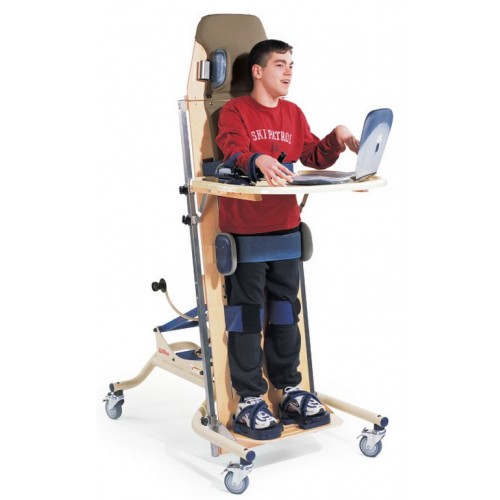
Functional Rifton stand (Rifton rear tilt verticalizer)
A functional desk supports the user in a standing position and differs from an orthostatic (tilting) table in that it allows for greater control of the position of the head, torso, pelvis, knees and feet.
Robust, stable supporting frame. Particularly suitable for users with insufficient regulation of a stable vertical position of the head and shoulder girdle.
With one handle you can adjust the horizontal height and bring the rehabilitation equipment into a vertical position.
The side support blocks and armrests recline, and the patient receives the necessary freedom of movement. When lying down you need maximum stability.
A functional stance supports the back of the body. Side support blocks provide symmetry, while body straps provide security. The position of any part is adjustable, which allows you to give the correct position to the patient’s head, torso, pelvis, knees and feet.
The well-secured patient is transferred to an upright position. Manual tilt angle adjustment is efficient and reliable. The speed of movement depends on the degree of tolerance by the patient. The closer the position of the device is too vertical, the easier the adjustment handle moves due to the gas lift and the supporting frame mechanism. An adjustable tray can be used to support the patient's hands and provide space for work or play.
Patients with flexion contractures and who are not weight bearing can be positioned in the Functional Stance so that only the force of their extensor muscles is used.
In the stand, the patient is clearly visible from all sides, which allows for optimal adjustment of his position. Wheels make the stand easy to move.
Sizes: E 420 for height 76-127 cm and E 430 for height 117-183 cm Additional physiological benefits of Rifton rehabilitation equipment:
In an upright position, gravity has a positive effect on all body systems.
The respiratory system relaxes and is easier to cleanse.
The digestive and excretory systems are under less stress, which improves motility and renal function.
The vascular system strengthens over time, which leads to increased tolerance to an upright body position and reduces the likelihood of fainting. Observing the surrounding space in a vertical position improves the mental and mental state of the patient, expands the possibilities of using the tray, and improves communication with others.
